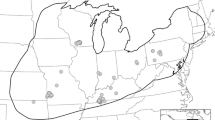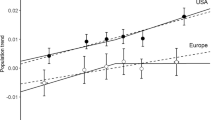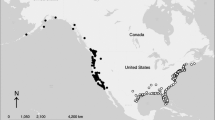Abstract
Climatic factors act on populations at multiple timescales leading to the separation of long-term climate and shorter-term weather effects. We used passerine counts from 1995 to 2019 in subarctic Alaska (Denali National Park, USA) to assess the impacts of the prior breeding season’s weather on breeding season abundance and the impacts of climate measured through shifts in elevational distribution. Weather and climate appear to have had opposing effects on the abundance of some shrub-associated species as evidenced by a positive response to nesting phase temperature over a 1-year lag and a negative response to warming-induced shifts in shrub-dominated habitats over the long term. The latter response was indicated by declines in abundance which occurred in some part through portions of these populations shifting upslope of our fixed sampling frame. Overall, the abundance of species was related to one or more of the lagged effects of weather and the effects of weather alone drove nearly twofold variation in annual abundance in most species. The effect of nesting phase temperature was a strong positive predictor at both community and individual species levels, whereas arrival phase temperature had weak support at both levels. The effects of total precipitation during the nesting phase and snowmelt timing shared mixed support at community and species levels, but generally indicated higher abundance following seasons that were drier and had earlier snowmelt. Together, our findings of opposing effects of climatic variables at different timescales have implications for understanding the mechanisms of population and distributional change in passerines in the subarctic.





Similar content being viewed by others
References
Anders AD, Post E (2006) Distribution-wide effects of climate on population densities of a declining migratory landbird. J Anim Ecol 75:221–227
Barker RJ, Schofield MR, Link WA, Sauer JR (2018) On the reliability of N-mixture models for count data. Biometrics 74:369–377
Benson AM, Winker K (2001) Timing of breeding range occupancy among high-latitude passerine migrants. Auk 118:513–519
Boelman NT, Krause JS, Sweet SK, Chmura HE, Perez JH, Gough L, Wingfield JC (2017) Extreme spring conditions in the Arctic delay spring phenology of long-distance migratory songbirds. Oecologia 185:69–80
Bolduc E, Casajus N, Legagneux P, McKinnon L, Gilchrist HG, Leung M, Morrison RG, Reid D, Smith PA, Buddle CM, Bêty J (2013) Terrestrial arthropod abundance and phenology in the Canadian Arctic: modelling resource availability for Arctic-nesting insectivorous birds. Can Entomol 145:155–170
Brodie JF, Roland CA, Stehn SE, Smirnova E (2019) Variability in the expansion of trees and shrubs in boreal Alaska. Ecology 100:02660
Brooks SP, Gelman A (1998) General methods for monitoring convergence of iterative simulations. J Comput Graph Stat 7:434–455
Brown CR, Brown MB (2000) Weather-mediated natural selection on arrival time in cliff swallows (Petrochelidon pyrrhonota). Behav Ecol Sociobiol 47:339–345
Bystrack D (1981) The North American breeding bird survey. Stud Avian Biol 19:34–41
Chmura HE, Krause JS, Pérez JH, Asmus A, Sweet SK, Hunt KE, Meddle SL, McElreath R, Boelman NT, Gough L, Wingfield JC (2018) Late-season snowfall is associated with decreased offspring survival in two migratory arctic-breeding songbird species. J Avian Biol 49:e01712
Clegg BF, Hu FS (2010) An oxygen-isotope record of Holocene climate change in south-central Brooks Range, Alaska. Quat Sci Rev 29:928–939
Custer TW, Osborn RG, Pitelka FA, Gessaman JA (1986) Energy budget and prey requirements of breeding Lapland Longspurs near Barrow, Alaska, USA. Arct Antarct Alp Res 18:415–427
Denwood MJ (2016) runjags: an R Package providing interface utilities, model templates, parallel computing methods and additional distributions for MCMC models in JAGS. J Stat Softw 71:1–25
Gelman A (2006) Prior distributions for variance parameters in hierarchical models (comment on article by Browne and Draper). Bayes Anal 1:515–534
Gibson DD (2011) Nesting shorebirds and landbirds of interior Alaska. Report for U.S. Geological Survey, Alaska Science Center, Anchorage
Gorzo JM, Pidgeon AM, Thogmartin WE, Allstadt AJ, Radeloff VC, Heglund PJ, Vavrus SJ (2016) Using the North American Breeding Bird Survey to assess broad-scale response of the continent’s most imperiled avian community, grassland birds, to weather variability. Condor Ornithol Appl 118:502–512
Høye TT, Forchhammer MC (2008) Phenology of high-arctic arthropods: effects of climate on spatial, seasonal, and inter-annual variation. Adv Ecol Res 40:299–324
Hussell DJ, Montgomerie R (2002) Lapland longspur (Calcarius lapponicus). In: Rodewald PG (ed) The birds of North America online. Cornell Lab of Ornithology, Ithaca
Kendeigh SC (1969) Tolerance of cold and Bergmann’s Rule. Auk 86:13–25
Klaassen M, Lindstrom A, Meltofte H, Piersma T (2001) Arctic waders are not capital breeders. Nature 413:794–794
Krause JS, Pérez JH, Chmura HE, Sweet SK, Meddle SL, Hunt KE, Gough L, Boelman N, Wingfield JC (2016) The effect of extreme spring weather on body condition and stress physiology in lapland longspurs and white-crowned sparrows breeding in the Arctic. Gen Comp Endocrinol 237:10–18
Lanctot RB, Laredo CD (1994) Buff-breasted sandpiper (Calidris subruficollis). In: Rodewald PG (ed) The birds of North America online. Cornell Lab of Ornithology, Ithaca
Link WA, Sauer JR (1997) Estimation of population trajectories from count data. Biometrics 53:488–497
Low M, Pärt T (2009) Patterns of mortality for each life-history stage in a population of the endangered New Zealand stitchbird. J Anim Ecol 78:761–771
Martin K, Wiebe KL (2004) Coping mechanisms of alpine and arctic breeding birds: extreme weather and limitations to reproductive resilience. Integr Comp Biol 44:177–185
Meltofte H, Piersma T, Boyd H, McCaffery B, Ganter B, Golovnyuk VV, Graham K, Gratto-Trevor CL, Morrison RIG, Nol E, Rösner H-U, Schamel D, Schekkerman H, Soloviev MY, Tomkovich PS, Tracy DM, Tulp I, Wennerberg L (2007) Effects of climate variation on the breeding ecology of Arctic shorebirds. Medd Grønl Biosci 59:1–48
Meltofte H, Høye TT, Schmidt NM (2008) Effects of food availability, snow and predation on breeding performance of waders at Zackenberg. In: Meltofte H, Christensen TR, Elberling B, Forchammer MC, Rasch M (eds) High-arctic ecosystem dynamics in a changing climate. Elsevier Academic Press Inc., San Diego, pp 325–341
Mitchell GW, Guglielmo CG, Wheelwright NT, Freeman-Gallant CR, Norris DR (2011) Early life events carry over to influence pre-migratory condition in a free-living songbird. PLoS ONE 6:e28838
Mizel JD, Schmidt JH, McIntyre CL, Roland CA (2016) Rapidly shifting elevational distributions of passerine species parallel vegetation change in the subarctic. Ecosphere 7:e01264
Mizel JD, Schmidt JH, McIntyre CL, Lindberg MS (2017) Subarctic-breeding passerines exhibit phenological resilience to extreme spring conditions. Ecosphere 8:e01680
Morrison CA, Robinson RA, Butler SJ, Clark JA, Gill JA (2016) Demographic drivers of decline and recovery in an Afro-Palaearctic migratory bird population. Proc R Soc B Biol Sci 283:20161387
Morton ML, Horstmann JL, Osborn JM (1972) Reproductive cycle and nesting success of the Mountain White-crowned Sparrow (Zonotrichia leucophrys oriantha) in the central Sierra Nevada. Condor 74:152–163
Myers-Smith IH, Hik DS (2017) Climate warming as a driver of tundra shrubline advance. J Ecol 106:547–560
Norris DR, Marra PP, Kyser TK, Sherry TW, Ratcliffe LM (2004) Tropical winter habitat limits reproductive success on the temperate breeding grounds in a migratory bird. Proc R Soc Lond Ser B Biol Sci 271:59–64
Öberg M, Arlt D, Pärt T, Laugen AT, Eggers S, Low M (2015) Rainfall during parental care reduces reproductive and survival components of fitness in a passerine bird. Ecol Evol 5:345–356
Pearce-Higgins JW, Eglington SM, Martay B, Chamberlain DE (2015a) Drivers of climate change impacts on bird communities. J Anim Ecol 84:943–954
Pearce-Higgins JW, Ockendon N, Baker DJ, Carr J, White EC, Almond RE, Amano T, Bertram E, Bradbury RB, Bradley C, Butchart SH (2015b) Geographical variation in species’ population responses to changes in temperature and precipitation. Proc R Soc B Biol Sci 282:20151561
Pérez JH, Krause JS, Chmura HE, Bowman S, McGuigan M, Asmus AL, Meddle SL, Hunt KE, Gough L, Boelman NT, Wingfield JC (2016) Nestling growth rates in relation to food abundance and weather in the Arctic. Auk 133:261–272
Plummer M (2003) JAGS: a program for analysis of Bayesian graphical models using Gibbs sampling. http://www.r-project.org/conferences/DSC-2003/Drafts/Plummer.pdf. Accessed 17 Aug 2017
Post E, Forchhammer MC, Bret-Harte MS, Callaghan TV, Christensen TR, Elberling B, Fox AD, Gilg O, Hik DS, Høye TT, Ims RA (2009) Ecological dynamics across the Arctic associated with recent climate change. Science 325:1355–1358
R Core Team (2018) R: a language and environment for statistical computing. R Foundation for Statistical Computing, Vienna, Austria
Roland CA, Schmidt JH, Johnstone JF (2014) Climate sensitivity of reproduction in a mast-seeding boreal conifer across its distributional range from lowland to treeline forests. Oecologia 174:665–677
Roots EF (1989) Climate change: high-latitude regions. Clim Change 15:223–253
Rushing CS, Dudash MR, Studds CE, Marra PP (2015) Annual variation in long-distance dispersal driven by breeding and non-breeding season climatic conditions in a migratory bird. Ecography 38:1006–1014
Saino N, Szép T, Romano M, Rubolini D, Spina F, Møller AP (2004) Ecological conditions during winter predict arrival date at the breeding quarters in a trans-Saharan migratory bird. Ecol Lett 7:21–25
Skagen SK, Adams AAY (2012) Weather effects on avian breeding performance and implications of climate change. Ecol Appl 22:1131–1145
Socolar JB, Epanchin PN, Beissinger SR, Tingley MW (2017) Phenological shifts conserve thermal niches in North American birds and reshape expectations for climate-driven range shifts. Proc Natl Acad Sci USA 114:12976–12981
Stewart B, Kunkel K, Stevens L, Sun L, Walsh J (2013) Regional climate trends and scenarios for the US national climate assessment: part 7. Climate of Alaska. NOAA Technical Report NESDIS 142-7. National Oceanic and Atmospheric Association, Silver Spring, Maryland, USA
Studds CE, Marra PP (2011) Rainfall-induced changes in food availability modify the spring departure programme of a migratory bird. Proc R Soc B Biol Sci 278:3437–3443
Stueve KM, Isaacs RE, Tyrrell LE, Densmore RV (2011) Spatial variability of biotic and abiotic tree establishment constraints across a treeline ecotone in the Alaska Range. Ecology 92:496–506
Tingley MW, Beissinger SR (2009) Detecting range shifts from historical species occurrences: new perspectives on old data. Trends Ecol Evol 24:625–633
Tingley MW, Koo MS, Moritz C, Rush AC, Beissinger SR (2012) The push and pull of climate change causes heterogeneous shifts in avian elevational ranges. Glob Change Biol 18:3279–3290
Tulp I, Schekkerman H (2008) Has prey availability for arctic birds advanced with climate change? Hindcasting the abundance of tundra arthropods using weather and seasonal variation. Arctic 61:48–60
Visser ME, Both C, Lambrechts MM (2004) Global climate change leads to mistimed avian reproduction. Adv Ecol Res 35:89–110
Walther GR, Post E, Convey P, Menzel A, Parmesan C, Beebee TJ, Fromentin JM, Hoegh-Guldberg O, Bairlein F (2002) Ecological responses to recent climate change. Nature 416:389–395
Wilson S, LaDeau SL, Tøttrup AP, Marra PP (2011) Range-wide effects of breeding-and nonbreeding-season climate on the abundance of a neotropical migrant songbird. Ecology 92:1789–1798
Wingfield JC (2008) Organization of vertebrate annual cycles: implications for control mechanisms. Philos Trans R Soc Lond B Biol Sci 363:425–441
Acknowledgements
We thank the many people that conducted surveys over the course of this project. Funding for this work was provided through the NPS Central Alaska and Arctic Inventory and Monitoring Networks, and Denali National Park and Preserve. Comments from two anonymous reviewers on a previous draft improved the manuscript. Any reference to trade names does not imply endorsement by the U.S. government.
Author information
Authors and Affiliations
Contributions
JDM, JHS, and CLM conceived and designed the experiments. CLM and JDM performed the experiments. JDM analyzed the data. JDM and JHS wrote the manuscript.
Corresponding author
Additional information
Communicated by Hannu Pöysä.
Supplementary Information
Below is the link to the electronic supplementary material.
Rights and permissions
About this article
Cite this article
Mizel, J.D., Schmidt, J.H. & Mcintyre, C.L. Climate and weather have differential effects in a high latitude passerine community. Oecologia 195, 355–365 (2021). https://doi.org/10.1007/s00442-020-04847-x
Received:
Accepted:
Published:
Issue Date:
DOI: https://doi.org/10.1007/s00442-020-04847-x




